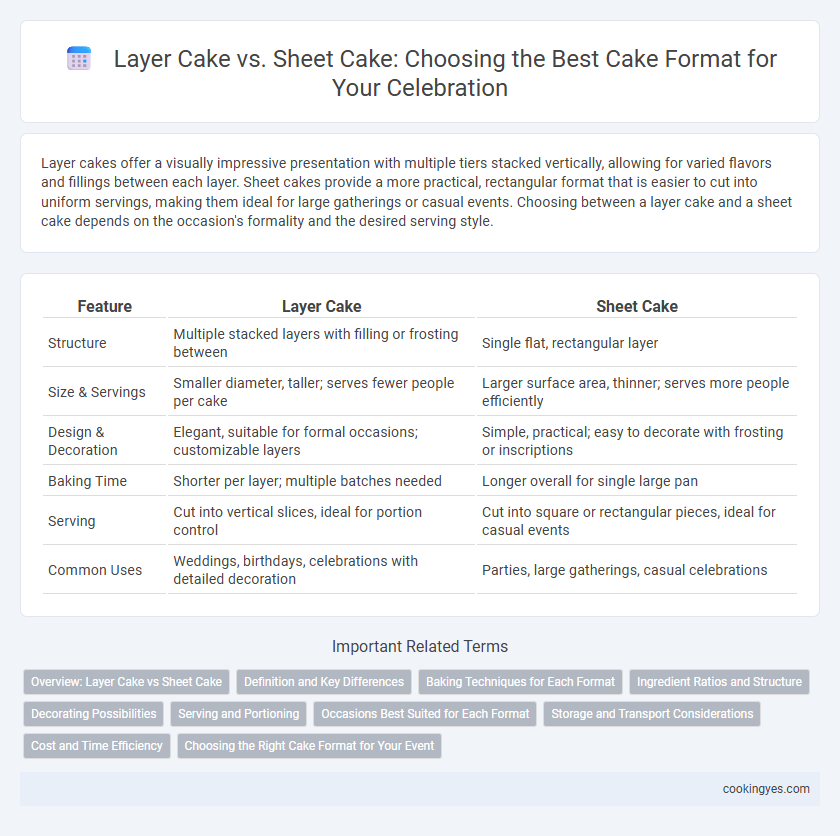Layer cakes offer a visually impressive presentation with multiple tiers stacked vertically, allowing for varied flavors and fillings between each layer. Sheet cakes provide a more practical, rectangular format that is easier to cut into uniform servings, making them ideal for large gatherings or casual events. Choosing between a layer cake and a sheet cake depends on the occasion's formality and the desired serving style.
Table of Comparison
| Feature | Layer Cake | Sheet Cake |
|---|---|---|
| Structure | Multiple stacked layers with filling or frosting between | Single flat, rectangular layer |
| Size & Servings | Smaller diameter, taller; serves fewer people per cake | Larger surface area, thinner; serves more people efficiently |
| Design & Decoration | Elegant, suitable for formal occasions; customizable layers | Simple, practical; easy to decorate with frosting or inscriptions |
| Baking Time | Shorter per layer; multiple batches needed | Longer overall for single large pan |
| Serving | Cut into vertical slices, ideal for portion control | Cut into square or rectangular pieces, ideal for casual events |
| Common Uses | Weddings, birthdays, celebrations with detailed decoration | Parties, large gatherings, casual celebrations |
Overview: Layer Cake vs Sheet Cake
Layer cakes consist of multiple stacked tiers separated by frosting or filling, offering a visually appealing and elegant presentation ideal for formal occasions. Sheet cakes are baked in large, flat pans, providing a simpler, more cost-effective option suitable for serving large groups efficiently. Both formats vary in serving size, preparation time, and decorative possibilities, influencing the choice based on event requirements and personal preference.
Definition and Key Differences
Layer cake consists of multiple stacked cake layers with frosting or filling between each, creating a tall, elegant structure ideal for celebrations. Sheet cake is a single, flat, rectangular or square cake baked in a shallow pan, offering a simpler, more practical option for large gatherings. The key differences lie in presentation, preparation time, and serving style, with layer cakes requiring more assembly and sheet cakes providing ease of portioning.
Baking Techniques for Each Format
Layer cakes require precise stacking and crumb coating techniques to ensure even layers and smooth finishes, often involving baking multiple thin cake rounds separately. Sheet cakes demand uniform baking temperatures to avoid uneven rising and thorough cooling before frosting to prevent melting or sliding. Mastery of batter consistency and timing is essential for both formats to achieve optimal texture and shape.
Ingredient Ratios and Structure
Layer cakes typically require a higher fat-to-flour ratio to ensure moistness and stability across multiple tiers, whereas sheet cakes balance sugar and leavening agents to achieve a uniform crumb suitable for wide, flat surfaces. The denser structure of layer cakes supports stacking without collapsing, benefiting from firmer buttercream or ganache to maintain shape. Sheet cakes often use a lighter batter with increased eggs for elasticity and a delicate crumb, optimizing slicing and serving for larger groups.
Decorating Possibilities
Layer cakes offer extensive decorating possibilities with their multi-tiered structure, ideal for intricate designs using fondant, buttercream, or edible flowers. Sheet cakes provide a larger flat surface suitable for detailed piping, stenciling, and custom edible images, making them perfect for personalized messages and simpler decorations. Both formats allow creativity but differ in presentation and complexity of decoration techniques.
Serving and Portioning
Layer cakes offer a visually impressive presentation with multiple tiers, allowing for distinct flavors between layers and precise portioning typically yielding 8 to 12 servings per 9-inch cake. Sheet cakes provide a larger surface area and are easier to cut into uniform, rectangular portions, ideal for serving large groups with consistent sizing, often accommodating 20 to 40 servings depending on pan dimensions. Choosing between layer and sheet cake formats depends on balancing elegant aesthetics with ease of serving and portion control for events.
Occasions Best Suited for Each Format
Layer cakes are ideal for formal celebrations such as weddings, anniversaries, and milestone birthdays where presentation and height create an impressive centerpiece. Sheet cakes suit casual gatherings like office parties, school events, and large family reunions due to their ease of serving and ability to feed many people efficiently. Selecting the cake format depends on the occasion's scale and the desired visual impact.
Storage and Transport Considerations
Layer cakes require careful stabilization during storage and transport to maintain their structure, often needing cake boxes with internal supports or refrigeration to prevent melting or shifting. Sheet cakes offer easier handling and storage due to their flat shape, fitting more conveniently into standard containers and refrigerators without the risk of tiers collapsing. Choosing between the two depends on the balance between presentation priorities and logistical constraints such as vehicle size and ambient temperature.
Cost and Time Efficiency
Layer cakes typically require more time and labor for assembly and decoration, leading to higher costs compared to sheet cakes. Sheet cakes offer greater cost efficiency by simplifying baking and serving processes, making them ideal for large gatherings with minimal preparation time. Choosing a sheet cake format optimizes both budget and time without compromising on portion size.
Choosing the Right Cake Format for Your Event
Layer cakes offer a visually stunning option with multiple tiers that can accommodate elegant designs and varied flavors, making them ideal for formal events and celebrations that require a centerpiece. Sheet cakes provide a practical solution for serving large groups, ensuring uniform slices and easier transport, which suits casual gatherings and corporate events. Selecting between a layer cake and a sheet cake hinges on factors like event size, desired presentation, and ease of serving.
Layer Cake vs Sheet Cake for cake format Infographic

 cookingyes.com
cookingyes.com